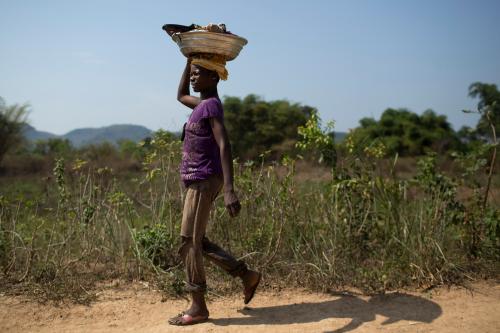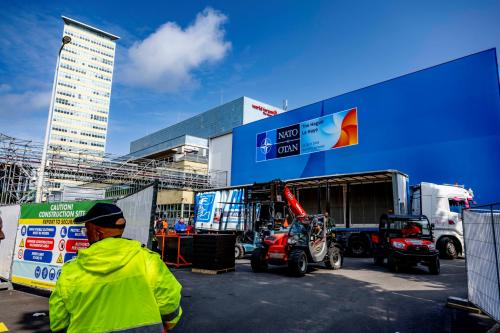Five years ago—before the Trump presidency and Brexit, among other phenomena—we looked at major trends and forces affecting the “aid industry” over the 2025 horizon. That horizon has arguably become even more uncertain. We revisit it in a new paper that asks which of the forces we analyzed have enduring power, which may turn out to be ephemeral, and what we missed but may have lasting implications. Here are our five key findings:
Fragility is the new development frontier
There are now more people living in poverty in fragile states than in other developing countries, and their numbers are growing due to stagnant economies coupled with fast-growing populations. This combination slows down dramatically the rate at which the global poverty numbers can be reduced, absent a major shift in international attention and support.
This is an alarm call. History will judge today’s development community by how effectively it deals with fragility. To begin addressing this fragility, we suggest a massive investment in modern civil registration and vital statistics systems—boring but essential institutional building blocks—and sustained pressure on international agencies to demonstrate that they can pool their efforts effectively in fragile states.
The shrinking size of the overall poverty gap
Juxtaposed against this warning message is an optimistic one about the relatively small investment needed to close the poverty gap in developing countries. We calculate that about $75 billion per year, equal to just 0.1 percent of world GDP of $75 trillion, would be enough to lift everyone on the planet to the international poverty line, assuming perfect targeting and no administrative costs. Moreover, if developing countries themselves were to devote 1 percent more of their national income to closing their national poverty gaps (much less for larger economies with smaller gaps, like China), then rich countries could close the remaining funding gap by using only one-third of their current aid, or $45 billion (This is 60 percent of the total gap, almost exactly the current share of advanced countries in global GDP, a crude but appealing indicator of fairness). The fact that closing the gap is potentially affordable does not mean that identifying, reaching, and helping all the poor in all these countries will become magically easy or 100 percent effective overnight. But it is no longer complete pie-in-the-sky financially, as it may once have been. The key policy lever is to develop effective and scalable social safety nets that can, in turn, be funded by domestic resources or aid. Increasingly, evidence suggests that cash transfers, whether conditional or unconditional, will prove to be a scalable and effective approach.
Cooperation of middle-income countries in tackling global challenges
To address problems like climate change and surges in migrant flows, we need to drop any lingering policy obsession with arbitrary country per capita income categories, which are flawed for other reasons, as the overriding criterion for distributing so-called “concessional” aid. Instead, we should channel aid through middle-income countries, whenever it is appropriate to cover effective management of major regional and global spillover effects. We call this approach “gradation, not graduation.” For example, World Bank loans to Jordan and Lebanon on softer terms are supporting innovative regional solutions for the reintegration of displaced Syrians. Carbon emissions that threaten us all need to be tackled in the countries where they are most heavily generated, which are not usually the poorest. Similar considerations apply to containing cross-border disease contagion and preserving global financial stability.
Competitive engagement with China
Chinese development efforts are setting new benchmarks against which Western aid agencies will be increasingly judged in terms of motivation (mutual benefit), efficiency, and perhaps effectiveness. They will need to play catchup, as, for example, the two largest Chinese banks, China Development Bank and China Export-Import Bank, already hold roughly the same total international assets ($680 billion) as all the western-origin multilateral development banks (MDBs) put together. The key will be strategically competitive, and complementary, Western development agency engagement in countries where Chinese bilateral aid will be concentrated (particularly those involved in the Belt and Road Initiative), and intensified partnership with the new Chinese-headquartered MDBs. Our report shows which aid donors are more and less exposed to China’s new geographical focus.
Realistic expectations for private sector mobilization for development
The historical pendulum of optimism and pessimism about the scope for greater corporate for-profit investment to social good is currently on the bullish end of the spectrum—partly given the likely disruptive power of new technologies like mobile payments, block-chains, and biometric identification applied to developing country contexts, and partly given the increased attention to sustainability by corporate officers and directors. We should nonetheless keep in mind underlying limitations to public-private partnerships, such as fears of market distortions and corruption, which can swing the pendulum back. More immediately, few aid agencies as yet track systematically the private funds they claim to “mobilize,” or even participate in regular international surveys to establish what that level might be, using a transparent common definition. That has to change.
Moreover, behind the well-worn slogans of “turning billions into trillions,” we were disappointed at the small, and falling, amounts of private funding for infrastructure that MDBs report they have mobilized recently. Their owners must work to reverse this trend, including by using the full capacity of their balance sheets, taking on reasonable additional risks without necessarily raising fresh capital, and by experimenting with new partnerships that build platforms of larger scale, often based in national development banks.
The world is shifting, and aid agencies need to respond. The old narrative of celebrating the huge gains in poverty reduction over the past two decades will not long hold up to the scrutiny of publics asking what good their tax dollars are doing today.
The Brookings Institution is committed to quality, independence, and impact.
We are supported by a diverse array of funders. In line with our values and policies, each Brookings publication represents the sole views of its author(s).







Commentary
Back to the future: 5 lenses on the future of global development
October 2, 2017